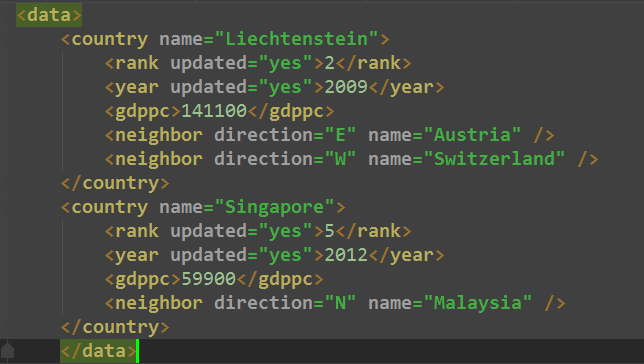python xml模块
发布时间:2018-03-02 16:22:34编辑:admin阅读(4882)
xml是实现不同语言或程序之间进行数据交换的协议,跟json差不多,但json使用起来更简单,不过,古时候,在json还没诞生的黑暗年代,大家只能选择用xml呀,至今很多传统公司如金融行业的很多系统的接口还主要是xml。
xml的格式如下,就是通过<>节点来区别数据结构的:
<?xml version="1.0"?> <data> <country name="Liechtenstein"> <rank updated="yes">2</rank> <year>2008</year> <gdppc>141100</gdppc> <neighbor name="Austria" direction="E"/> <neighbor name="Switzerland" direction="W"/> </country> <country name="Singapore"> <rank updated="yes">5</rank> <year>2011</year> <gdppc>59900</gdppc> <neighbor name="Malaysia" direction="N"/> </country> <country name="Panama"> <rank updated="yes">69</rank> <year>2011</year> <gdppc>13600</gdppc> <neighbor name="Costa Rica" direction="W"/> <neighbor name="Colombia" direction="E"/> </country> </data>
xml协议在各个语言里的都 是支持的,在python中可以用以下模块操作xml
#!/usr/bin/env python
# coding: utf-8
__author__ = 'www.py3study.com'
import xml.etree.ElementTree as ET
#读取并解析xml文件
tree = ET.parse("xmltest.xml")
#获得root节点
root = tree.getroot()
#节点标签名
print(root.tag)
# 遍历xml文档
for child in root:
#child.tag就是country,child.attrib就是country的属性,就是name值
print(child.tag, child.attrib)
for i in child:
#i.tag就是country里面的之列表,比如rank
#i.text就是子列表显示的值,比如2
print(i.tag, i.text)
# 只遍历year 节点
for node in root.iter('year'):
print(node.tag, node.text)执行输出
data
country {'name': 'Liechtenstein'}
rank 2
....
修改和删除xml文档内容
#!/usr/bin/env python
# coding: utf-8
__author__ = 'www.py3study.com'
import xml.etree.ElementTree as ET
tree = ET.parse("xmltest.xml")
root = tree.getroot()
# 修改
for node in root.iter('year'):
#获取每一个年,加1
new_year = int(node.text) + 1
node.text = str(new_year)
#增加属性updated
node.set("updated", "yes")
tree.write("xmltest.xml")
# 删除node
for country in root.findall('country'):
#获取country下的rank值
rank = int(country.find('rank').text)
#当大于50,就删除
if rank > 50:
root.remove(country)
tree.write('output.xml')执行程序,查看output.xml文件内容

自己创建xml文档
#!/usr/bin/env python
# coding: utf-8
__author__ = 'www.py3study.com'
import xml.etree.ElementTree as ET,re
#根节点
new_xml = ET.Element("personinfolist")
#SubElement子节点,new_xml节点名,attrib属性
personinfo = ET.SubElement(new_xml, "personinfo", attrib={"enrolled": "yes"})
name = ET.SubElement(personinfo, "name")
name.text = "Zhang Shao Han"
age = ET.SubElement(personinfo, "age", attrib={"checked": "no"})
sex = ET.SubElement(personinfo, "sex")
#设置属性值
age.text = '23'
personinfo2 = ET.SubElement(new_xml, "personinfo", attrib={"enrolled": "no"})
name = ET.SubElement(personinfo2, "name")
name.text = "Liu Yi Fei"
age = ET.SubElement(personinfo2, "age")
age.text = '19'
et = ET.ElementTree(new_xml) # 生成文档对象
#xml_declaration表示头部信息
et.write("test.xml", encoding="utf-8", xml_declaration=True)
ET.dump(new_xml) # 打印生成的格式执行程序,查看test.xml文件
由于默认的write方法,写入文件,代码都挤到一块了。
使用网页工具,进行展示
http://tool.oschina.net/codeformat/xml/
<?xml version="1.0" encoding="utf-8"?> <personinfolist> <personinfo enrolled="yes"> <name>Zhang Shao Han</name> <age checked="no">23</age> <sex/> </personinfo> <personinfo enrolled="no"> <name>Liu Yi Fei</name> <age>19</age> </personinfo> </personinfolist>
上一篇: python shelve模块
- openvpn linux客户端使用
51691
- H3C基本命令大全
51347
- openvpn windows客户端使用
41785
- H3C IRF原理及 配置
38556
- Python exit()函数
33031
- openvpn mac客户端使用
30055
- python全系列官方中文文档
28716
- python 获取网卡实时流量
23706
- 1.常用turtle功能函数
23630
- python 获取Linux和Windows硬件信息
21995
- Python搭建一个RAG系统(分片/检索/召回/重排序/生成)
2193°
- Browser-use:智能浏览器自动化(Web-Agent)
2887°
- 使用 LangChain 实现本地 Agent
2401°
- 使用 LangChain 构建本地 RAG 应用
2351°
- 使用LLaMA-Factory微调大模型的function calling能力
2914°
- 复现一个简单Agent系统
2355°
- LLaMA Factory-Lora微调实现声控语音多轮问答对话-1
3148°
- LLaMA Factory微调后的模型合并导出和部署-4
5180°
- LLaMA Factory微调模型的各种参数怎么设置-3
5002°
- LLaMA Factory构建高质量数据集-2
3575°
- 姓名:Run
- 职业:谜
- 邮箱:383697894@qq.com
- 定位:上海 · 松江
